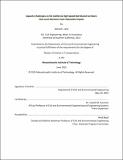Capacity challenges on the California high-speed rail shared corridors : how local decisions gave statewide impacts
Author(s)
Levy, Samuel J. (Samuel Joseph)
DownloadFull printable version (3.263Mb)
Other Contributors
Massachusetts Institute of Technology. Department of Civil and Environmental Engineering.
Advisor
Joseph M. Sussman
Terms of use
Metadata
Show full item recordAbstract
In 2012, as a cost-control measure and in response to local opposition in the San Francisco Bay Area, the California High-Speed Rail Authority (CHSRA) adopted a "blended system" at the north and south bookends of the planned first phase of its high-speed rail line. In this blended operation, the high-speed rail line will share track and other infrastructure with commuter rail, intercity rail, and freight on the 50- mile Peninsula Corridor in Northern California and on 50 miles of right-of-way between Burbank, Los Angeles, and Anaheim in Southern California. This thesis provides a critical review of the blended system and discusses the level of cooperation and coordination necessary between host railroads and the high-speed rail tenant operator. In Northern California, the Peninsula Corridor Joint Powers Board's Caltrain commuter rail service between San Francisco and San Jose is experiencing record levels of ridership. This thesis explores the impact of both the electrification of the line and its extension into San Francisco's central business district on future ridership demand. With the California High-Speed Rail Authority competing spatially and temporally with Caltrain for access to high-revenue and high-cost infrastructure, we review different strategies for coordination and integration between the two agencies. In Southern California, the final form of the blended system is more nebulous than its northern counterpart. For the first few years of high-speed rail service, the Metrolink service operated by the Southern California Regional Rail Authority is expected to complement the high-speed rail system. However, since Metrolink operates on congested rail infrastructure, some of it owned by capacity-conscious freight railroads, there will exist the challenge of providing quality service and transfer opportunities for time-sensitive high-speed rail customers. The change to a blended system was a dramatic change of direction for the CHSRA; as a result, a new paradigm is needed for implementation of the system over the next 15 years. This thesis reviews the upcoming local design choices to be made on the local rail corridors and evaluates them from the perspective of the future statewide rail network. We find that the decisions made on the local blended corridor level will affect both the financial viability of the overall project and the quality of service experienced by customers across the entire California rail system.
Description
Thesis: S.M. in Transportation, Massachusetts Institute of Technology, Department of Civil and Environmental Engineering, 2015. This electronic version was submitted by the student author. The certified thesis is available in the Institute Archives and Special Collections. Cataloged from student-submitted PDF version of thesis. Includes bibliographical references (pages 147-162).
Date issued
2015Department
Massachusetts Institute of Technology. Department of Civil and Environmental EngineeringPublisher
Massachusetts Institute of Technology
Keywords
Civil and Environmental Engineering.